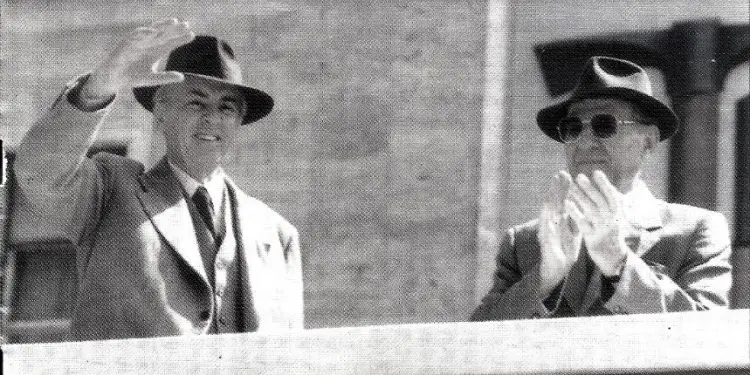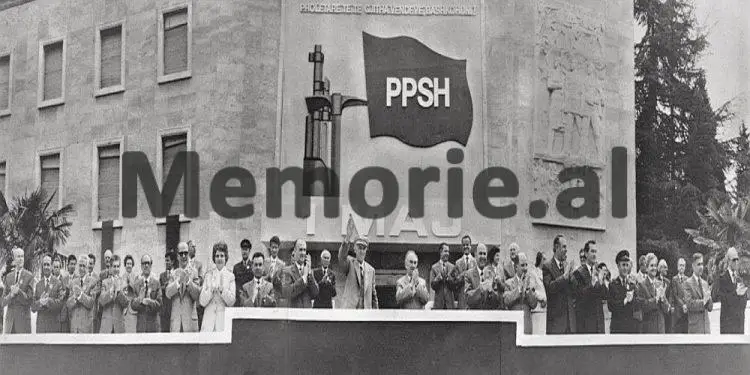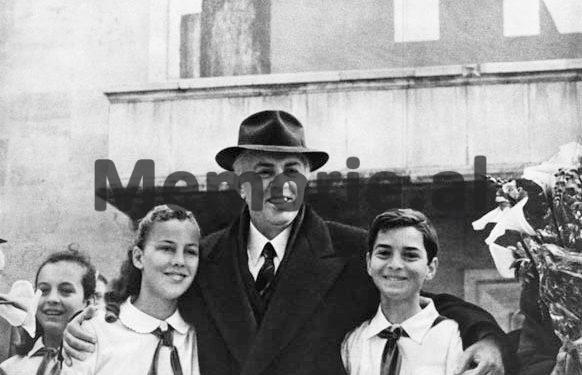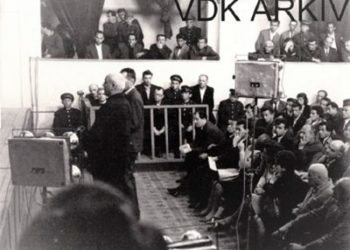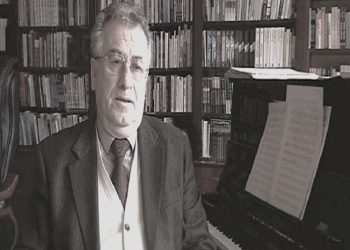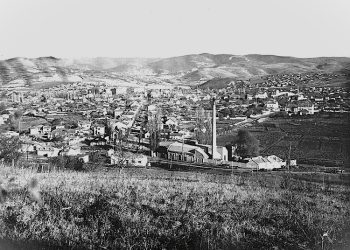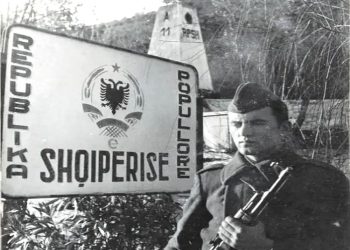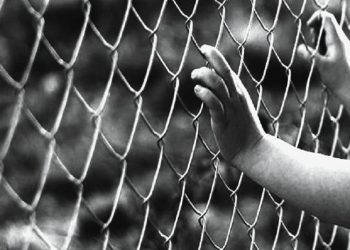By Adela Kolea
Memorie.al / A country from the post-war period until the early 1990s, which for about half a century, – lived under a dictatorship – led in a one-party manner by the only legal party and governing body in power, the Party of Labor (former Albanian Communist Party), it is clear that May 1 meant literally; also “Labor Day” or “Workers’ Day”. Today, this anniversary in Albania is no longer celebrated in the same way as before, since the change of political systems took place in the country – at the beginning of the 90s and in moments in which, generally at the global level, it has been transformed, in one day protests and demonstrations, in which the people demand their basic right, the one that gives meaning to this anniversary: “work”, which unfortunately is currently in short supply and people are caught in the clutches of the crisis…!
At that time, in Albania, on May 1 in the main square of Tirana, hundreds of thousands of people demonstrated happily, precisely to proudly demonstrate their successes in the workplace, in all production fronts. The achievements of the work, as the positive balance was reported, showed the state, which had guaranteed the citizens work, in accordance with the system in force.
Therefore, it was the “duty” of the working people, to show the exponents of the country’s high leadership, the high and positive results of the state economy, achieved during the year, and this on May 1, was proven at the same time, as a important opportunity to thank them, for the well-being of the people, from the perspective of work itself, guaranteed by the big “state company”.
A look at the history and conception of work in Albania during the dictatorial communist system
[…] This was the first tractor “Made in Albania”, produced by the Albanian mechanical industry in 1978, with its own forces, in an Albania under dictatorship and in complete autarky. Immediately after World War II, the struggle of the Albanian Communist Party began to transform the country; from a backward agricultural country, to an agricultural-industrial country.
The first Party Congress took place in 1948. The focus was on the basic work for the industrialization and electrification of the country. Industry: The decisive points were those inherent in the expansion of national production. Socialist industrialization should have been applied at a very fast rate, to bring the country out of backwardness, in record time, relying on the wealth of the land and underground, exploiting the little existing industry and creating a new one. In the countryside, the slogan was in force: “Support the poor peasant, alliance with the middle peasant and fight against the kulaks”! (Tedi Papavrami. Book: “Fugue for solo violin”)
Then the Albanian Communist Party formed in 1941 took the name of the Labor Party, to arrive by June 12, 1991, with the winds of political and social change blowing across Eastern Europe – already initialized with the fall of the Berlin Wall in 1989 – to change, definition for the Socialist Party of Albania.
The arrangement of human “squares”!
“Martyrs of the Nation” boulevard of Tirana, the most important central place of the capital, which has “Skënderbej Square” as its beginning and “Mother Teresa” Square as its end – among other things, a street designed by the Italian architect Gherardo Bosio during the Italian occupation of Albania in 1939 – in the years of the dictatorship, on May 1, it was invaded by a large crowd, hundreds of thousands of people, demonstrating and manifesting in front of the tribune erected for the Political Bureau of the Central Committee of the Party of Labor of Albania, headed by by dictator Enver Hoxha.
I even still have the official voice that accompanied the news of these manifestations on Radio-Television, Alfons Gurashi (I must say, a voice with a very beautiful and special timbre and intonation) and his professional comments, worthy of a excellent Albanian television journalist, who brought to every home, through the small screen, the emotions of this day that mobilized the whole country and ensured that everyone’s eyes were focused exclusively on the Albanian capital, Tirana, for this holiday.
People needed months and months of preparation for this manifestation. Arranged in a rigorously precise geometric manner, they consisted of large human squares, i.e. of people, who, euphoric about the event, continued walking at a marching pace along the road.
The first square that started the demonstration was that of the national flag bearers, then the other squares composed of various heavy industry workers, such as; miners, those who worked in the metallurgy, steel and energy sectors, etc. Next came the light industry and food industry cadres, and then we saw cadres of service workers, such as commerce, health and the capital’s Executive Committee workers, line up ready for the parade. Behind them were the cooperators and livestock workers of the state farms.
Then they paraded the groups of young volunteers, that is, those who voluntarily participated in the construction of state railways, hydropower plants or on the terraces of the hills. Then it was the turn of the squares with high school students and those from the State University of Tirana. Then, at least ten squads of Armed Forces soldiers arrived, but with light weapons on them.
Then, it was up to a giant square of high school students, as well as the so-called “Pioneers”, to perform, who put on a real show, loudly singing “The International”. The manifestation was closed with the performance of the artists’ quartet, such as those from Radio, Television, Kinostudio “alhħipria e Re”, Opera, Ballet, People’s Theater and then the press.
In this way, in front of the tribune, on the avenue, the traditional dances of the country were performed by artists dressed in Albanian folklore clothing and the same were sung by the National Ensemble of Folk Songs and Dances.
About 100,000 people marched in front of the tribune headed by Enver Hoxha, the members of the Political Bureau of the Central Committee of the PPSh, the Diplomatic Body accredited in Albania and many other guests of honor, who came from different countries of the world, who were representatives of Marxist-Leninist parties. The news about this event was also broadcast by many foreign televisions.
“Even the rain stopped, because Enver appeared on the stand”
“Even the rain stopped, because Enver came to the stand! He was the one who brought us the sun”! – the demonstrators and veterans cheered for the communist leader and dictator, Enver Hoxha, who was revered as a deity, so much so that Albanians had fallen into idolatry, because of his personality.
In this case, it so happened that it rained in Tirana during the May 1 popular demonstrations, at the exact moment that the main leader, Enver Hoxha, was going to enter the tribune, on the stage set up specially for the members of the Political Bureau, by some people , strange exclamations were made, because of the ideas embedded in their heads, that; “The sun would appear at the same time, when the supreme leader of the country, Enver Hoxha, appeared on the scene”!
“Do you want to see this really happen?” – some were challenging each other, so convinced, in a kind of bet that linked the communist leader, with a deity capable of performing miracles, including meteorological ones! These were just a part of the damage caused by the exaltation of the cult of the individual, which had reached extraordinary proportions in the dictatorial regime in Albania.
But after a while, they would probably understand that the appearance of the communist leader in the stands would not have that special power that people subjectively attributed to him. Those bouquets of colored crepe paper flowers, which they carried in their hands, made in the shape of a rose, which had a paper-covered wire instead of a stem, and which often accidentally pierced the hands, waving them over their heads, cheering the leader, drawing a portrait of him, as they would get wet from the rain, they would just fill all their clothes with stains…! But it wasn’t “panem et circenses” either. People really believed in this whole mobilization.
Decorative crepe paper flowers, which were used for the great May 1st demonstration
The distinctive symbol of the scenography of the demonstrations, the colored flowers made of crepe paper, which filled the hands of the squares who paraded for May 1st, are remembered by all Albanians, who belong to the so-called “generation of demonstrators”.
They were decorative flowers, which were packed by those in charge in advance and distributed to educational institutions or work and production centers, together with uniforms, intended for the next event.
On the morning of May 1, when I was still a child, with my friends, living a stone’s throw from the Boulevard “Dëshmorët e Kombit” in Tirana, where the great event took place, we went out and positioned ourselves on the edge of a large green. The lawn – on which we usually played during the week – waiting for all the demonstrators, who, to reach the square, would necessarily have passed by our field. This ground, among other things, was adjacent to the Italian Embassy.
From the square, they heard the sounds of some musical instrument or microphone. They were the experts, who performed the final technical acoustic tests, from the tribune intended for “comrades of the high leadership” of the Party of Labor of Albania.
We usually wore new clothes for the occasion. Happy and worried, we waited in line for the arrival of the demonstrators, strategically setting up, in our own way, “an ambush”.
Are you wondering why? To ask them to give us some crepe paper flowers, the ones that made up their bouquets and with which they would make their performance on the “Dëshmorët e Kombit” Boulevard!
They knew this “custom” of the children of the neighborhood next to the main square, so they kindly plucked some flowers from their artificial bouquet and threw them to us, becoming a great joy for us.
Considering that there were hundreds of people passing by, we children took so many paper flowers to take home that we didn’t know where to put them. In this way, in the houses of our neighborhood, the atmosphere of the 1st of May was strengthened and felt even more, because of these decorations that the children brought from outside, with their typical childish feats, but characteristic of the times in which they lived . Memorie.al





